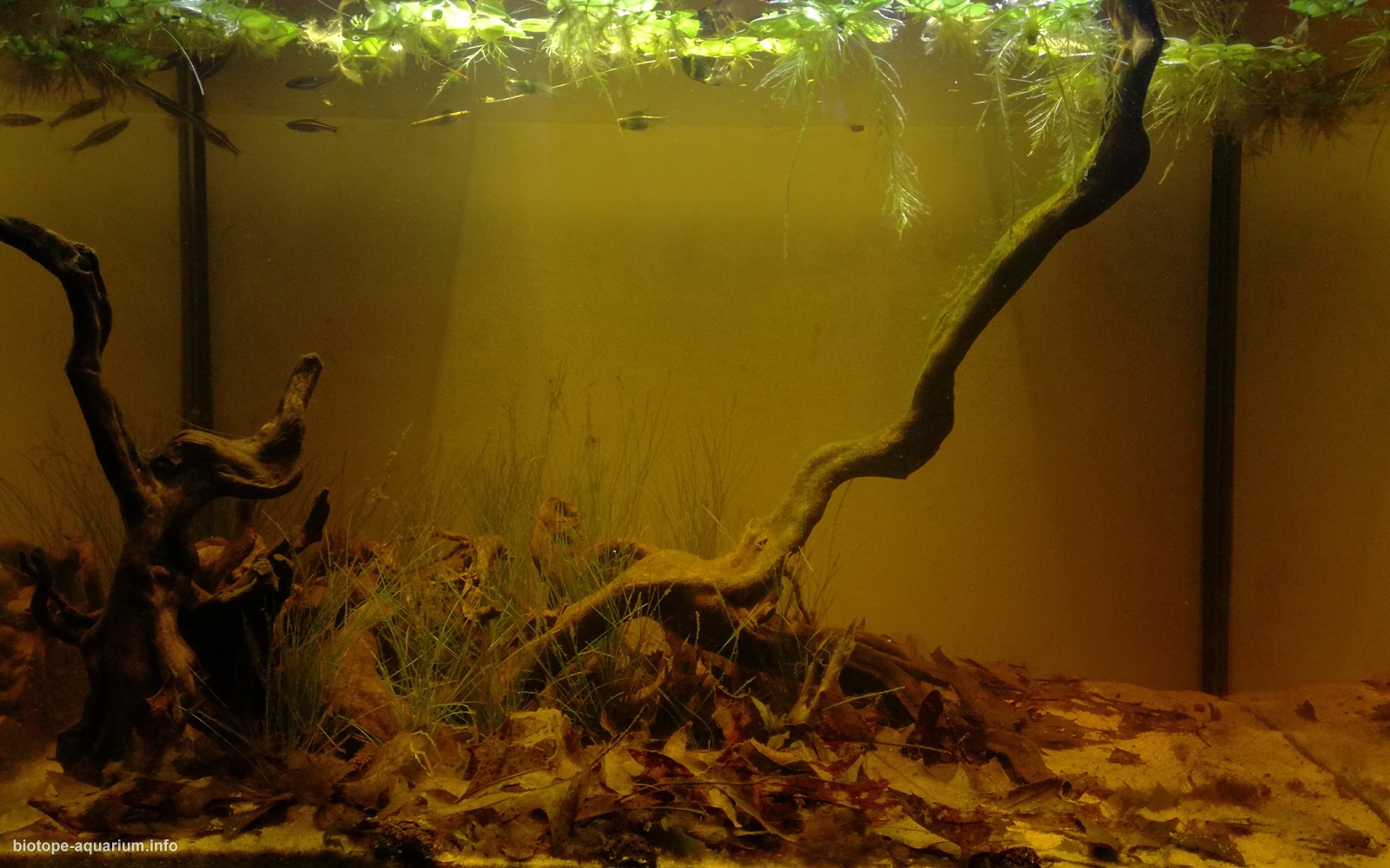Peat swamp forest in southern Johor state, Peninsular Malaysia
93rd place in Biotope Aquarium Design Contest 2018
![]() Netherlands. Christian Hidalgo Brandt
Netherlands. Christian Hidalgo Brandt

Volume: 70 L
Dimensions: 56x32x40 cm
List of fishes: Sphaerichthys osphromenoides, Betta coccina, Pangio semicincta, Trigonopoma pauciperforatum
List of plants: Eleocharis sp., Cryptocoryne cordata, Lemna minor, Salvinia natans, Pistia stratiotes, algae
Description of decorations: The substrate is sand covered by a layer of leaf litter. The wood used is spiderwood, used to simulate the roots of a fallen tree.
Description of equipment: Internal filter Superfish Aquaflow 100, 12w LED light bulb (6300K).
Water parameters: Temperature in the summer is 26-27 degrees Celcius, pH is 5,2, Kh is under 1, GH is under 1, TDS 25.
INFORMATION ABOUT BIOTOPE
Description of the area surrounding the biotope: Peat swamps are parts of forests where the the waterlogged soil prevents plant matter from fully decomposing, forming peat. Peat swamps are surrounded by rainforests with soils that do allow proper drainage. As these peat swamps rely heavily on rainwater, they can dry almost completely, only leaving small puddles where the fish await the next rainfall. The water is darkly stained by the humic acids released by decomposing plant matter. Due to the darkly stained water, as well as the dense tree canopy above, very little light reaches the bottom of the swamp. Though true aquatic vegetation is scarce, riparian vegetation is very common. These plants usually don’t grow underwater, but they are submerged after heavy rainfalls, and are able to survive fully submerged.
Description of the underwater landscape of the biotope: A thick layer of leaves, branches and other organic materials is formed on the bottom. The water is stained, the colour is similar to that of tea. There is almost no aquatic vegetation. The only plants found underwater are riparian plants, such as Eleocharis spp. or Cryptocoryne spp., when the banks flood after a heavy rainfall.
Description of the parameters of the habitat: The water is stained due to the humic acids released by the decaying plant matter. These acids make the water very acidic, the pH ranges between 3 and 6 depending on the season and location. The water hardness is below 50ppm, and the conductivity can be as low as 4 µS.
List of fishes and invertebrates occurring in the nature biotope: Sphaerichthys osphromenoides, Trigonopoma pauciperforatum, Desmopuntius hexazona, Trichopodus leerii, Boraras maculatus, Betta coccina, Betta livida, Parosphromenus harveyi, Pangio semicincta.
List of plants found in the nature biotope: Salvinia natans, Lemna minor, Eleocharis sp., Cryptocoryne spp., Pistia stratiotes, Blyxa spp., Limnophilla sessiliflora, Barclaya motleyi.
Threats to the ecology: The Malaysian peat swamps forests are threatened by logging, mining, and deforastation in order to make palm oil and coconut plantations.
It is estimated that only 25,3% of Peninsular Malaysia’s peat swamp forests remain undisturbed. This number will only get lower over the years, as only 4,5% of the original area is protected.
This means that many of the species that inhabit peat swamps (especially those that exclusively inhabit peat swamps, like Parosphromenus spp.), will be extinct in less than 10 years.
Sources of information:
https://www.seriouslyfish.com/
https://www.seriouslyfish.com/
https://www.seriouslyfish.com/
https://www.seriouslyfish.com/
https://smp.ibcbettas.org/
http://biotope-aquarium.info/
http://www.displa.org
https://academic.oup.com/
Comments of the members of the jury of Biotope Aquarium Design Contest 2018

This tank is not well balanced. Designwise there is too much open space. There are too few places for the fish to hide. They look stressed. Try to add more hiding places and definitely hold a close eye on water quality.
